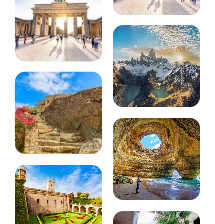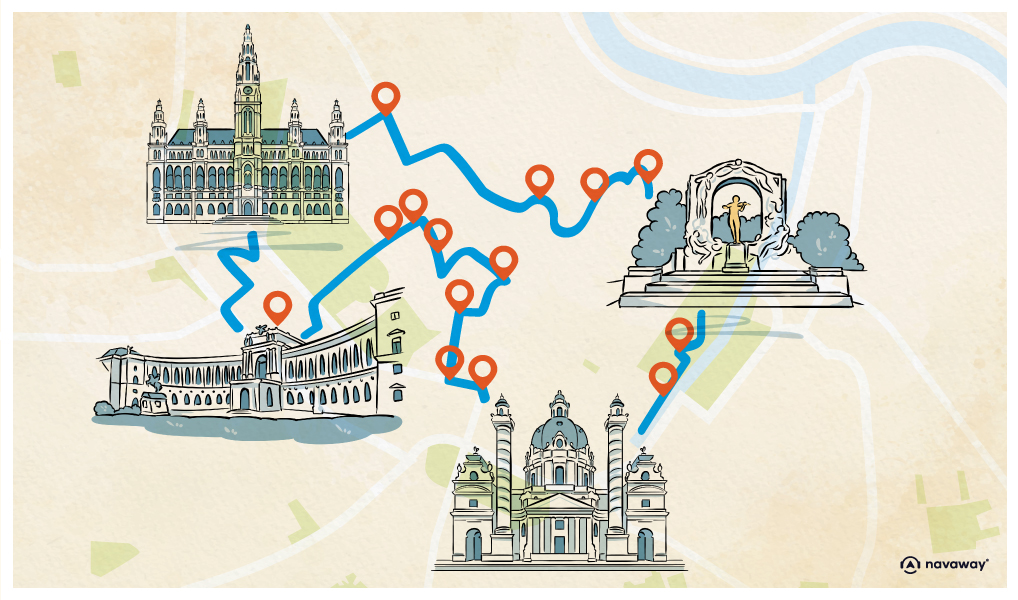
The 16 most beautiful places to visit in Austria
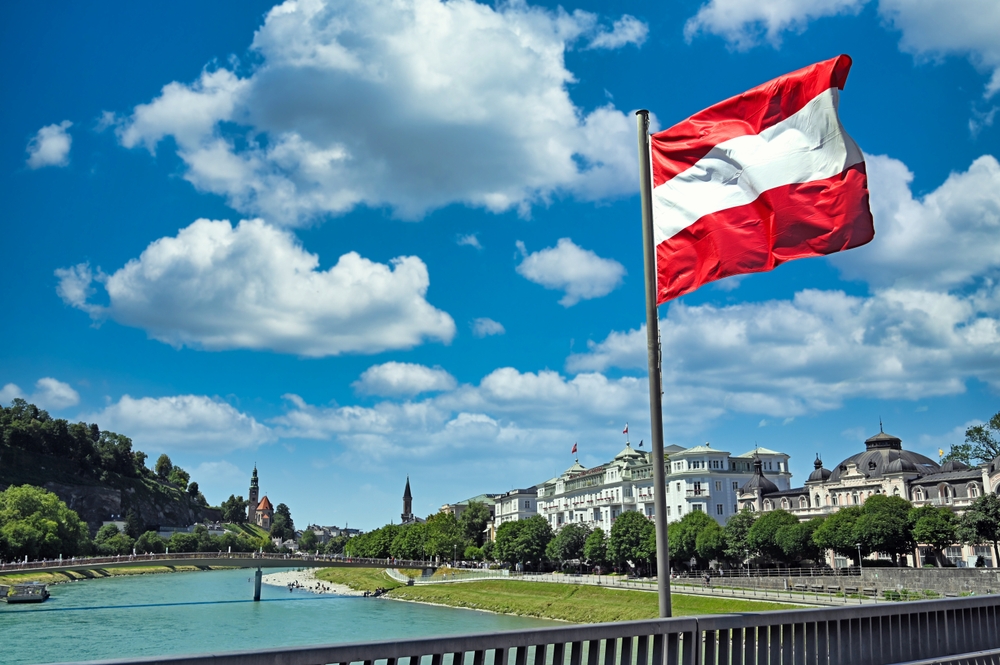
Austria is one of the most fascinating destinations in Central Europe. With its imperial cities steeped in history, picturesque Alpine villages and breathtaking mountain scenery, this country offers remarkable diversity. Whether you’re a lover of Baroque architecture, a keen hiker or simply looking for a change of scenery, Austria has something for everyone. From the majestic palaces of Vienna to the snow-capped peaks of the Tyrol and the crystal-clear lakes of Salzkammergut, each region reveals its own unique character. In this article, discover the 16 most beautiful places to visit in Austria for an unforgettable trip.

1. Vienna, the imperial capital
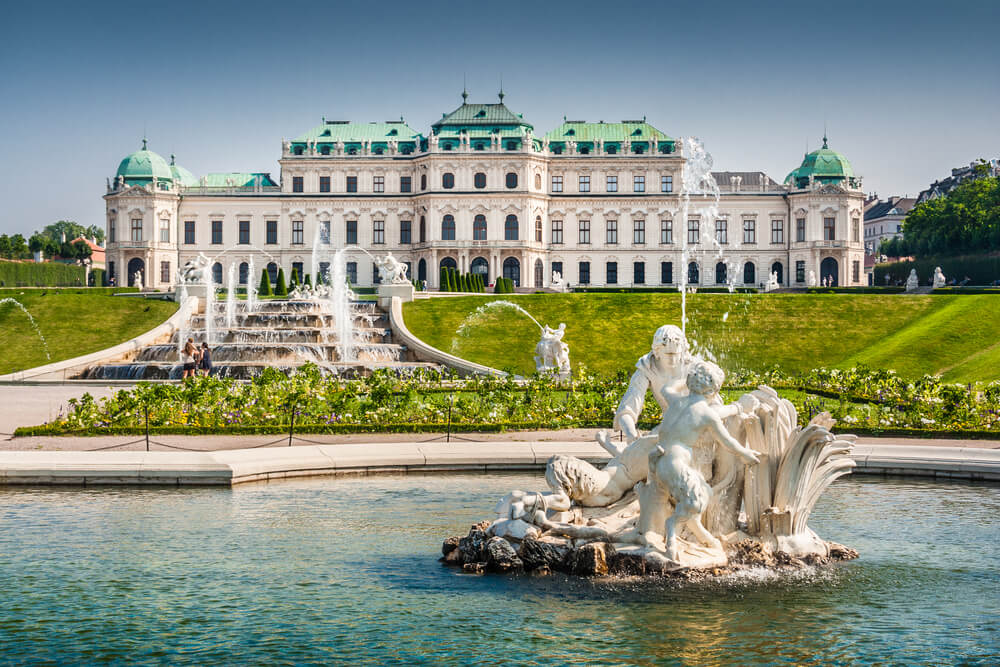
It’s impossible to visit Austria without discovering Vienna, its sumptuous capital. The former residence of the powerful Habsburg dynasty, the city exudes history and imperial grandeur around every corner. Schönbrunn Palace (Schönbrunner Schloßstraße 47, 1130 Wien, rated 4.6/5 on Google out of 44,309 reviews) remains one of Europe’s most visited monuments. This summer residence of the Austrian emperors, with its 1,441 rooms and formal gardens, bears witness to the splendour of the Baroque period.
Vienna’s historic centre, a UNESCO World Heritage Site, is also home to the Hofburg Palace, the former winter residence of the Habsburgs, and the Belvedere Palace, which today houses an impressive collection of Austrian art. St Stephen’s Cathedral (Stephansdom), with its roof of multi-coloured glazed tiles, has majestically dominated the city since the Middle Ages. And don’t miss the famous Ringstrasse, a circular avenue lined with monumental buildings such as the State Opera and Parliament.
Download the audio-guided tour to discover Vienne on foot and on your own
To explore Vienna in depth, the Navaway audio tour lets you discover the treasures of the Austrian capital at your own pace. This 7.9 km route takes you through the historic districts, from imperial palaces to legendary Viennese cafés and must-see museums. Thanks to the 26 points of interest with commentary, you’ll understand the soul of the city that gave birth to Mozart, Beethoven and Freud. Let us guide you on your visit to Vienna and immerse yourself in the unique atmosphere of this cultural metropolis.
Read also about the Vienne guide:
2. Hallstatt, the postcard village
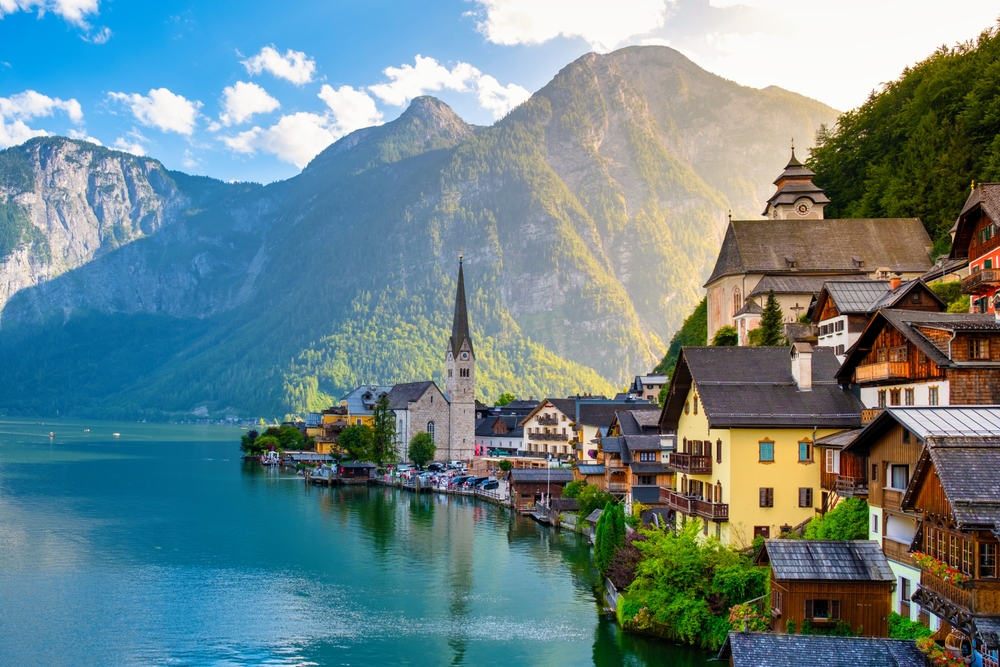
Nestling on the shores of Lake Hallstättersee in the Salzkammergut region, Hallstatt (4830 Hallstatt, rated 4.7/5 on Google with over 15,000 reviews) is one of the most photographed villages in the world. Its colourful half-timbered houses are reflected in the crystal-clear waters of the lake, creating a fairytale setting. Listed as a UNESCO World Heritage Site since 1997, this Alpine village embodies the quintessence of Austrian charm.
The history of Hallstatt dates back over 7,000 years, when salt mining was already a major industry in the region. In fact, you can visit the old Hallstatt salt mines, the oldest salt mines in the world still in operation. The village is also home to a unique ossuary, the Chapelle Saint-Michel, housing over 1,200 skulls painted in accordance with a centuries-old tradition. For an exceptional panoramic view of the village and lake, take the funicular to the Salzberg viewpoint.
3. Salzkammergut, the lake region
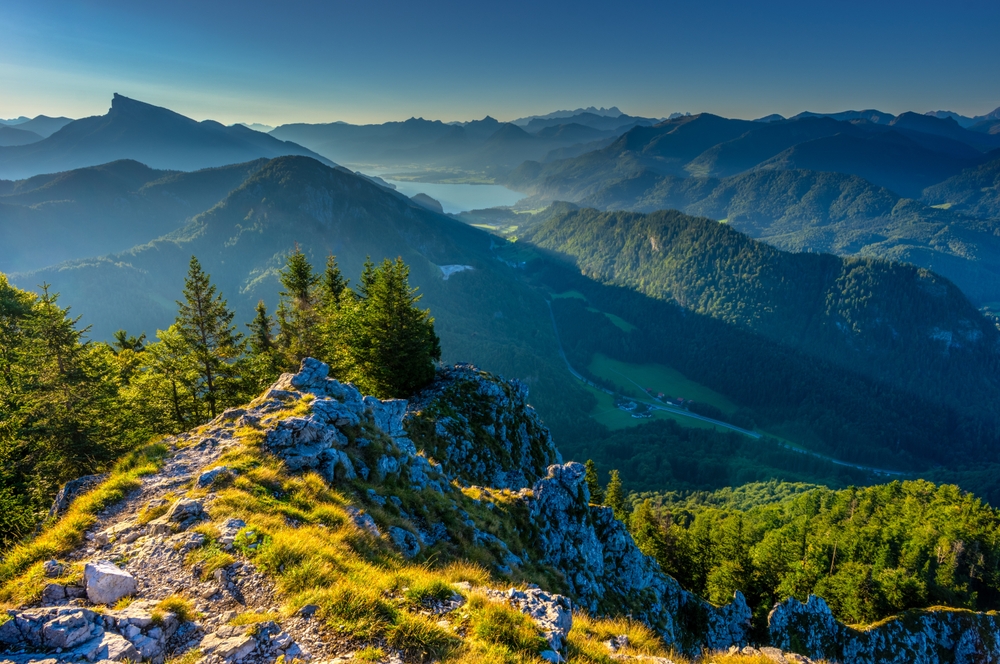
The Salzkammergut region spans three Austrian provinces and boasts no fewer than 76 Alpine lakes. This mountainous region offers breathtakingly beautiful scenery, where deep-blue lakes contrast with green peaks and sheer cliffs. Lake Mondsee, made famous by the film “The Sound of Music”, attracts water sports enthusiasts thanks to its relatively warm waters.
The village of Sankt Wolfgang (5360 Sankt Wolfgang im Salzkammergut, rated 4.7/5 on Google) is another gem of the Salzkammergut. With its Gothic pilgrimage church and picturesque lanes, it rivals Hallstatt in charm. Hikers will particularly appreciate the many signposted trails that criss-cross the region, offering exceptional views of the surrounding lakes and mountains. Don’t miss Lake Gosau, one of Austria’s most beautiful mountain lakes, with the Dachstein massif in the background.
4. The Dachstein massif and its glaciers
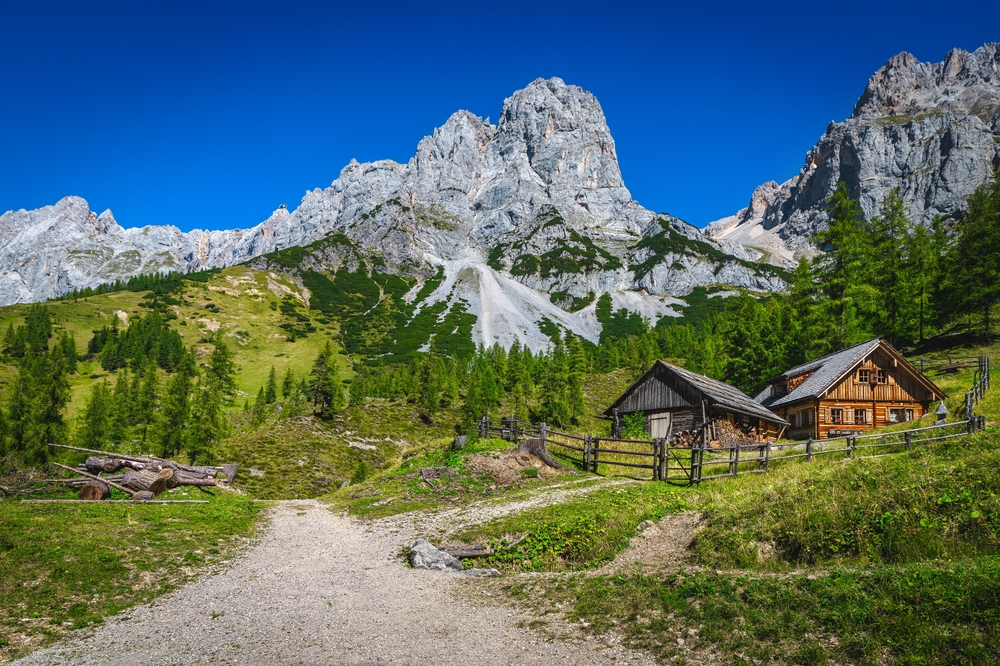
The Dachstein massif (4831 Obertraun, rated 4.7/5 on Google) rises to an altitude of 2,995 metres and is one of Austria’s most spectacular natural sites. From the village of Obertraun, a modern cable car takes you to the heart of this glacial massif. The main attraction remains the Dachstein ice caves, whose Rieseneishhle (giant ice cave) impresses with its natural sculptures of thousand-year-old ice.
At the top, the “5 Fingers” panoramic platform offers a vertiginous experience, with its plunging view over Lake Hallstättersee and the surrounding Alps. The more adventurous can also try out the “Treppe ins Nichts” (staircase into nothingness), a staircase suspended in the void with a transparent glass floor. In summer, the Dachstein becomes a hiker’s paradise, with its high-altitude paths offering breathtaking views. In winter, it’s the Dachstein ski area that attracts winter sports fans.
5. Salzburg, the city of Mozart
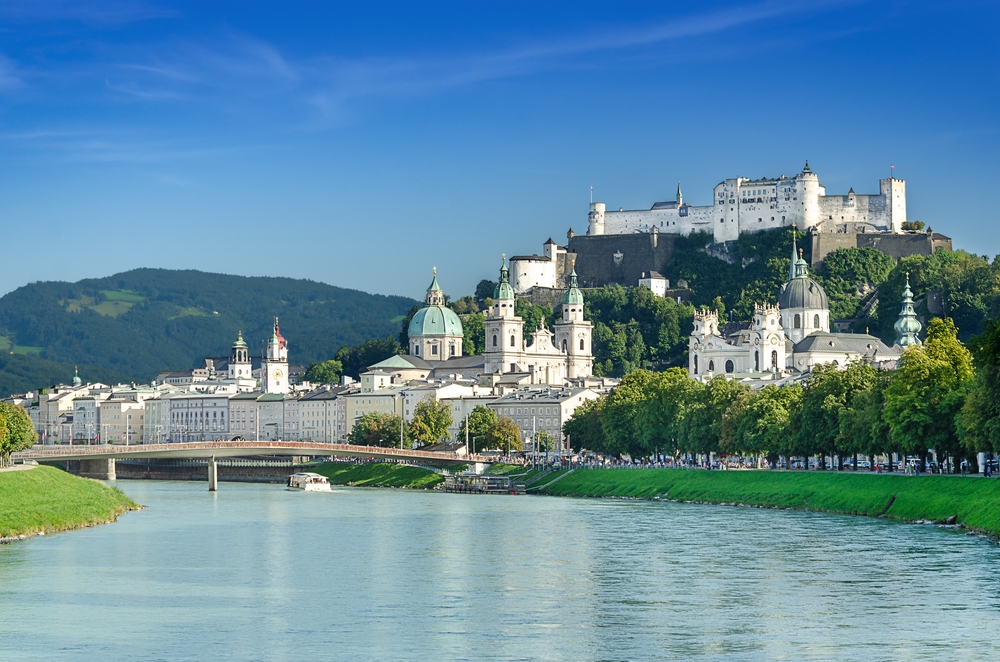
Austria’s fourth-largest city, Salzburg is world-famous for being the birthplace of Wolfgang Amadeus Mozart in 1756. The baroque old town, a UNESCO World Heritage Site, nestles at the foot of Mount Mönchsberg, dominated by the imposing Hohensalzburg Fortress (Mönchsberg 34, 5020 Salzburg, rated 4.5/5 on Google for over 30,000 reviews). This medieval citadel, one of the largest and best preserved in Europe, offers an exceptional panorama of the city and the Alps.
Take a stroll down Getreidegasse, the historic shopping street with its colourful facades and wrought-iron signs, home to Mozart’s birthplace. Other must-sees include Salzburg Cathedral, a Baroque masterpiece, and the gardens of Mirabell Palace. Every summer, the Salzburg Festival attracts music lovers from all over the world to celebrate classical music and opera. Salzburg’s Navaway itinerary allows you to discover all these treasures with 26 audio guides along a 4.3 km route.
6. The Grossglockner alpine route

The Grossglockner Alpine Road (Großglockner Hochalpenstraße) is one of the most beautiful mountain roads in the world. Only open from May to November, this 48-kilometre scenic route links the Salzburg region to Carinthia, crossing a pass at an altitude of 2,571 metres. It has 36 hairpin bends and offers breathtaking views of the snow-capped peaks of the Hohe Tauern National Park.
The Grossglockner (3,798 m, rated 4.8/5 on Google), Austria’s highest peak, majestically dominates the landscape. Along the way, you’ll find parking areas, scenic lookouts, mountain restaurants and information centres on Alpine flora and fauna. This is the ideal place to observe marmots in their natural habitat. Hikers can take several mountain trails from the road, while sport cyclists will find the climb a major challenge.
7. Hochosterwitz Castle in Carinthia
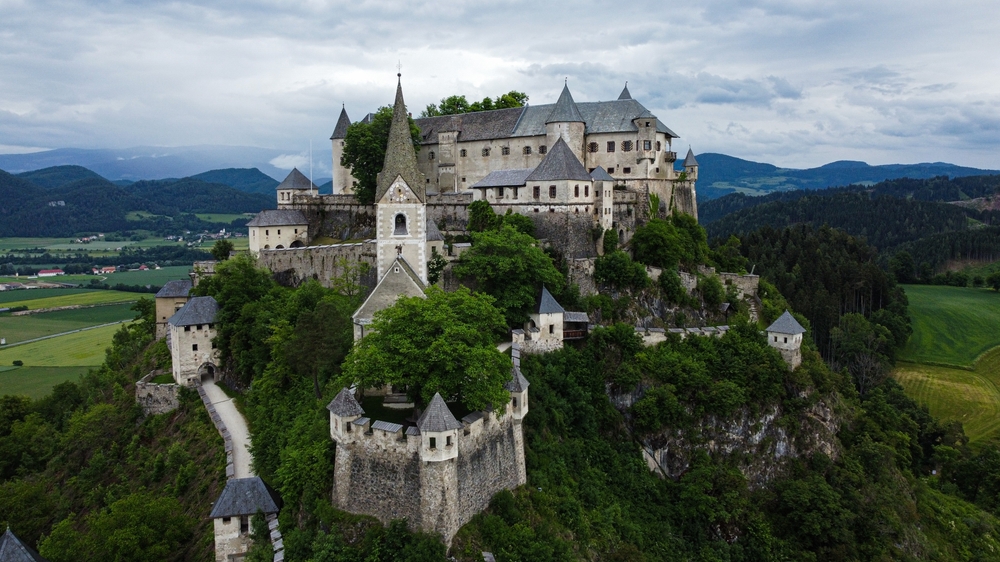
Perched on a rocky outcrop 175 metres high, Hochosterwitz Castle (Hochosterwitz 1, 9314 Launsdorf, rated 4.7/5 on Google out of over 8,000 reviews) is one of Europe’s most impressive medieval castles. Situated in Carinthia, not far from the town of Klagenfurt, this castle looks like something out of a medieval film. To reach the fortress, you have to pass through 14 successive fortified gates, each equipped with ingenious defence systems.
Built in the 9th century and extended in the 16th century, the castle has retained its authentic medieval character. From its ramparts, the view takes in the entire surrounding valley and stretches as far as the Alps. The most courageous can climb the 620-metre path on foot, but there is also a lift to the summit. Inside, the museum traces the fascinating history of the castle and its lords, while the armoury displays an impressive collection of medieval weapons and armour.
8. Graz, capital of Styria
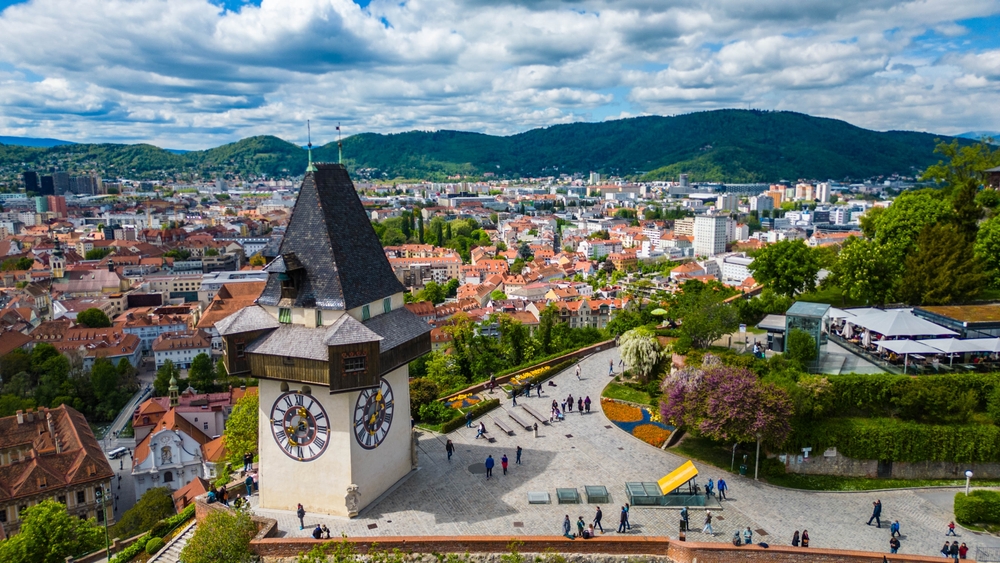
Austria’s second-largest city after Vienna, Graz has a very distinctive character. Its Old Town, a UNESCO World Heritage Site, boasts one of the finest ensembles of Renaissance architecture in Central Europe. The Schlossberg, the hill overlooking the city, offers a remarkable panorama and is home to the famous Clock Tower (Uhrturm), the symbol of Graz. You can reach it by funicular, or take the stairs if you’re more sporty.
Graz also stands out for its bold contemporary architecture. The Kunsthaus Graz (Lendkai 1, 8020 Graz, rated 4.3/5 on Google), nicknamed the “Friendly Alien” because of its futuristic shape, contrasts spectacularly with the surrounding historic buildings. Eggenberg Castle (Eggenberger Allee 90, 8020 Graz, Google rating: 4.6/5), a Baroque masterpiece on the outskirts of the city, is also worth a visit for its sumptuous gardens and richly decorated rooms. Graz is also renowned for its gastronomy and traditional cafés.
9. Grüner See, the ephemeral green lake

The Grüner See (Green Lake, 8612 Tragöß-Sankt Katharein, rated 4.6/5 on Google) is one of Austria’s most astonishing natural phenomena. Located at the foot of the Hochschwab massif in Styria, this lake is unique in that it only fills up in spring when the snow melts. In winter, the site is nothing more than a nature park with hiking trails and just a few metres of water.
But in spring and early summer, the melting glaciers transform the park into a lake up to 12 metres deep. What makes Grüner See absolutely unique is that the park’s benches, bridges and paths are then submerged under magnificent emerald-green crystal-clear water. Divers from all over the world come to admire this surreal spectacle of flower meadows and underwater paths. The best time to visit Grüner See is in June, when the water level is at its highest and underwater visibility is at its best.
10. The Tyrol and its Alpine valleys

Tyrol is the epitome of Alpine Austria. This mountainous region, through which the Inn flows, is the most visited in the country, thanks to its grandiose landscapes, preserved traditions and world-renowned ski areas. In winter, Tyrol welcomes millions of skiers on hundreds of kilometres of perfectly groomed slopes. Resorts such as Kitzbühel, Sölden and Ischgl are among the most prestigious in the Alps.
But Tyrol reveals all its splendour in summer, when the green alpine pastures are adorned with wild flowers and the hiking trails become accessible. The Tyrolean villages, with their wooden chalets with flower-filled balconies and bulbous churches, have preserved their traditional architecture. The Ötztal valley, with its glaciers and peaks over 3,000 metres high, offers endless opportunities for hiking and mountaineering. Achensee, Tyrol’s largest lake, captivates visitors with its turquoise waters and spectacular mountain scenery.
11. Innsbruck, capital of the Alps
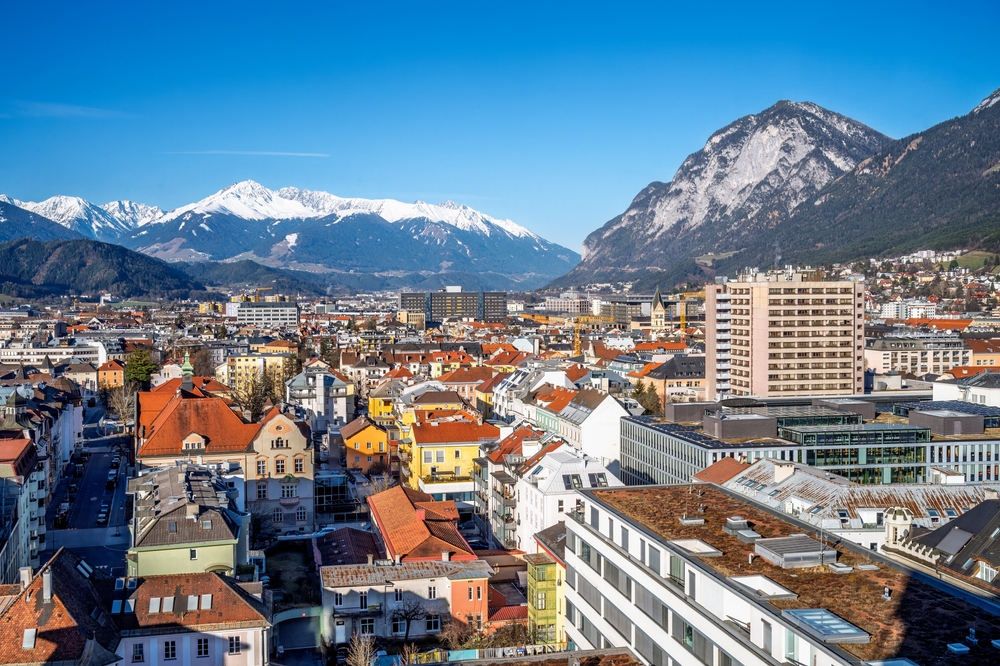
Nestling in a valley in the heart of the Tyrolean Alps, Innsbruck is a perfect blend of urban charm and Alpine splendour. The medieval old town, with its colourful houses and frescoed facades, contrasts with the surrounding snow-capped peaks. The symbol of the town is the Golden Roof (Goldenes Dachl), a Gothic balcony covered with 2,657 golden copper tiles. This loggia was built by Emperor Maximilian I in the 15th century.
The Imperial Palace of Innsbruck (Rennweg 1, 6020 Innsbruck, rated 4.5/5 on Google) bears witness to the city’s prestigious past as the former residence of the Habsburgs. But Innsbruck is best known for its direct access to the mountains: a few minutes by cable car from the city centre will take you to the Nordkette, 2,256 metres above sea level, with breathtaking panoramic views of the Alps. In winter, you can even ski in the morning and stroll through the streets of the historic centre in the afternoon. The Bergisel ski jump, an architectural masterpiece by Zaha Hadid, also offers spectacular views over the city.
12. Linz, the city on the Danube

Austria’s third-largest city, Linz is surprisingly dynamic and modern. Situated on the banks of the Danube in Upper Austria, it has reinvented itself by becoming a capital of contemporary culture and technological innovation. Hauptplatz, one of the largest medieval squares in Europe, is the historic heart of the city, with its Renaissance buildings and traditional cafés.
Mariendom Cathedral (Herrenstraße 26, 4020 Linz, rated 4.6/5 on Google) is Austria’s largest cathedral and can hold up to 20,000 people. Its bell tower offers exceptional views over the whole city and the Danube. Linz has also made a name for itself in contemporary art with the Ars Electronica Center, an interactive museum dedicated to new technologies, and the Lentos Kunstmuseum, which houses a remarkable collection of modern art. Linz Castle, perched on a hill, is home to a museum dedicated to the history of Upper Austria.
13. Melk Abbey on the Danube
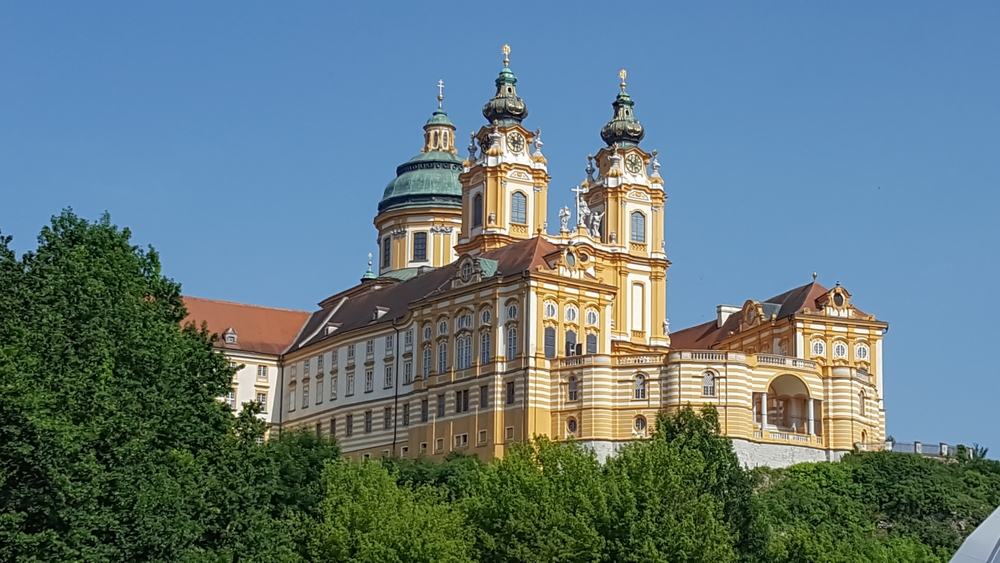
Built on a rocky spur overlooking the Danube, the Benedictine Abbey of Melk (Abt-Berthold-Dietmayr-Straße 1, 3390 Melk, rated 4.6/5 on Google out of over 15,000 reviews) is one of the finest examples of Austrian Baroque. Located around an hour from Vienna, this thousand-year-old abbey was rebuilt in the early 18th century in a flamboyant Baroque style. Its ochre facades and position overlooking the river make it one of Austria’s most photographed monuments.
The interior of the abbey is impressive for its rich decoration. The abbey church, with its frescoes, gilded stuccoes and monumental organ, is a masterpiece of Baroque art. But the real marvel is the library, with over 100,000 books, including precious medieval manuscripts. This sumptuous room, decorated with frescoes representing the theological virtues, is one of the most beautiful historical libraries in the world. The imperial flats, now a museum, provide an insight into the history of the abbey and its role in Austrian intellectual life. The panoramic terrace offers a magnificent view of the Wachau Valley, a wine-growing region listed as a UNESCO World Heritage Site.
14. Feldkirch, the medieval jewel of Vorarlberg
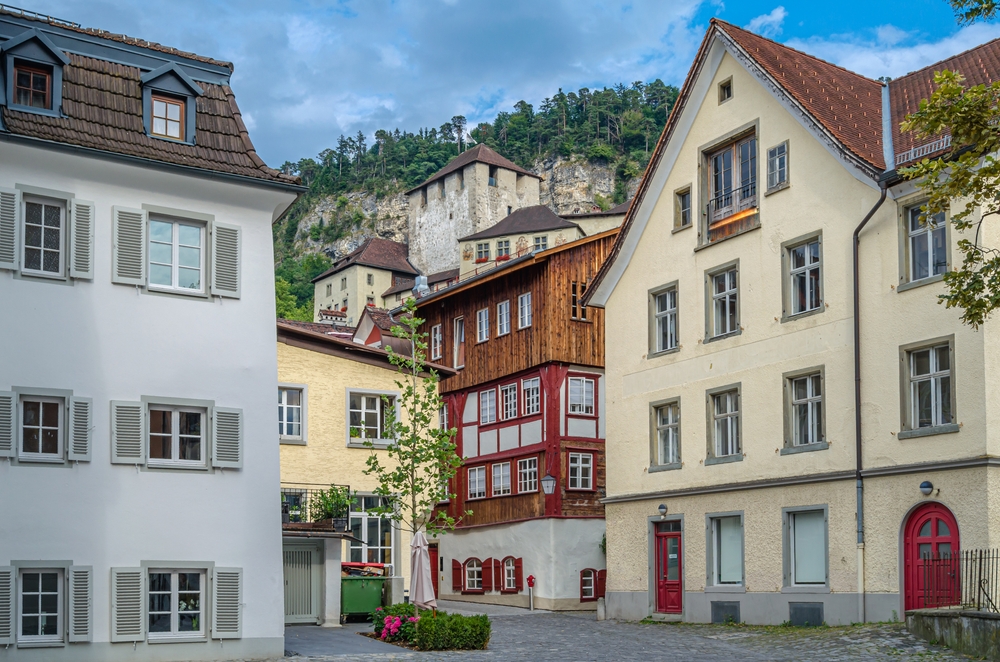
Located in the far west of Austria, on the border between Switzerland and Liechtenstein, Feldkirch (6800 Feldkirch, rated 4.6/5 on Google) is the best-preserved medieval town in Vorarlberg. Listed as a historic monument and a UNESCO World Heritage Site, it has retained its old-world charm, with ramparts, cobbled streets and half-timbered houses with colourful facades.
Schattenburg Castle (Burggasse 1, 6800 Feldkirch, rated 4.6/5 on Google), a medieval fortress dominating the old town, houses a fascinating museum devoted to regional history. The Cat Tower (Katzenturm), a vestige of the old fortifications, and St Nicholas’ Cathedral, a Romanesque masterpiece, are among the town’s landmarks. Feldkirch is particularly lively in summer during the Poolbar Festival, a musical event attracting over 20,000 visitors over a six-week period. The old town, with its medieval arcades and shady squares, is an inviting place to stroll and discover the local crafts.
15. Bregenz and Lake Constance
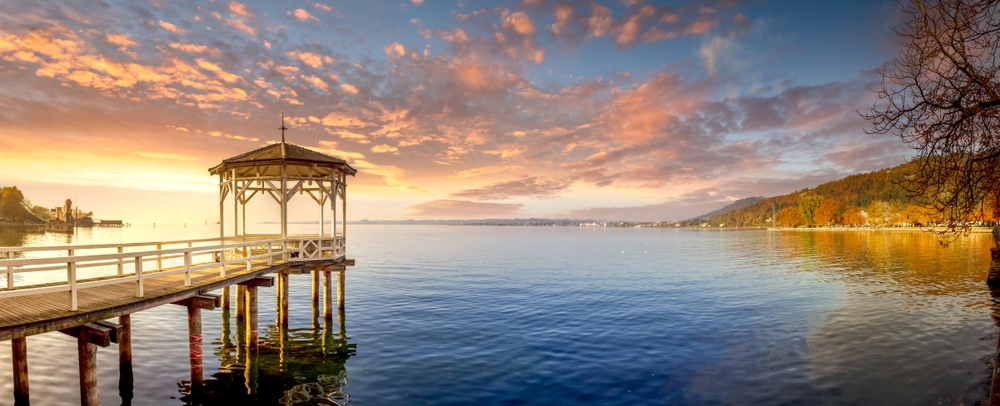
The capital of Vorarlberg, Bregenz (6900 Bregenz, rated 4.5/5 on Google) enjoys an exceptional location on the eastern shore of Lake Constance (Bodensee), at the foot of the Alps. This unique position offers an enchanting setting where Austrian, German and Swiss influences mingle. The old upper town, perched on the hill, has retained its medieval character with its narrow streets and old houses.
Bregenz is world-famous for its Bregenz Festival (Bregenzer Festspiele), which takes place every summer from July to August. The special feature of this opera and classical music festival is its monumental floating stage on the lake, the Seebühne. This spectacular stage, which is renewed every two years, can accommodate up to 7,000 spectators and features grandiose backdrops. The performances, with the lake and mountains as a backdrop at sunset, create an unforgettably magical atmosphere. Outside the festival, Bregenz is a popular destination for walks along the lake, the Kunsthaus Bregenz museum of modern art and the Pfänder cable car, which offers exceptional views of Lake Constance and the Alps.
16. Saint Florian Abbey near Linz
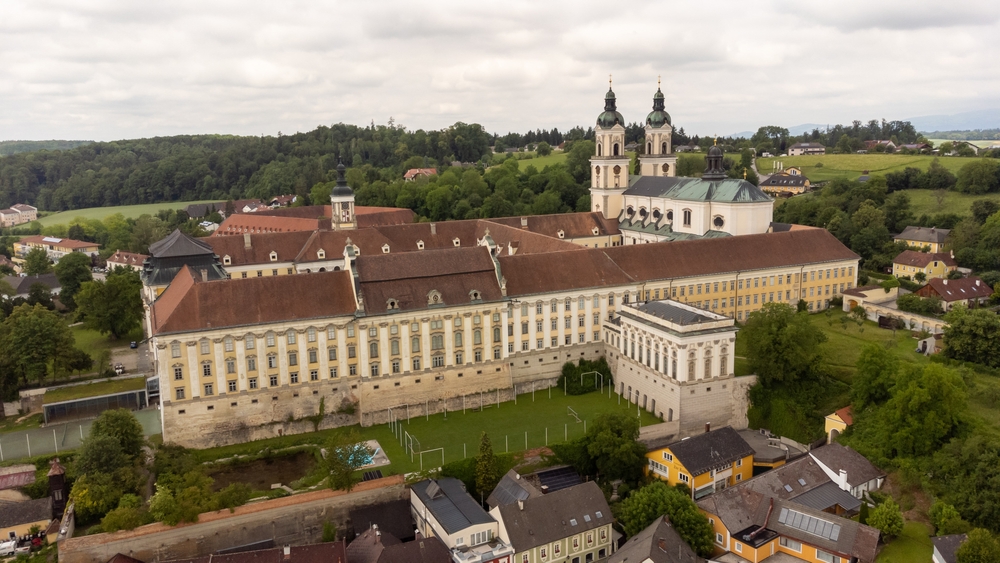
Located around fifteen kilometres south of Linz,Saint Florian Abbey (Stiftstraße 1, 4490 Sankt Florian, rated 4.7/5 on Google) is Austria’s largest and most prestigious Baroque abbey. Founded in the 8th century, it is one of the oldest surviving abbeys in the world. The current building, rebuilt between 1686 and 1751, impresses with its monumental dimensions and the richness of its Baroque decoration.
The Saint-Florian library is one of the finest in Europe, with over 150,000 volumes, including precious medieval manuscripts. Its sumptuous rooms, adorned with frescoes and gilded stucco, look as if they have stepped straight out of an imperial palace. The abbey church, with its exuberant Baroque interior, is home to Bruckner’s famous organ. The composer Anton Bruckner, who was organist at Saint Florian’s, is buried in the church crypt beneath his beloved organ. The abbey has 7,343 organ pipes, making it one of the largest instruments in Austria. The princely flats and the marble hall bear witness to the splendour with which the prince-abbots lived. The church’s exceptional acoustics and the power of the instrument can be appreciated at regular organ concerts.
In conclusion, Austria offers a remarkable diversity of destinations that will appeal to all types of traveller. From the imperial palaces of Vienna to the Alpine villages of the Tyrol, from the crystal-clear lakes of Salzkammergut to the Baroque abbeys of the Danube valley, each region reveals its own unique character. Whether you’re a history buff, a nature enthusiast or simply in search of beautiful scenery, these 16 places are must-sees for discovering the soul of Austria. Don’t hesitate to use the Navaway audioguide itineraries to explore cities like Vienna or Salzburg in depth and make the most of your trip to Austria.
Frequently asked questions about the most beautiful places to visit in Austria
When is the best time to visit Austria?
The ideal time to visit Austria depends on your interests. To discover the towns and Alpine landscapes in summer, choose the months of June to September, when the weather is pleasant and all the tourist sites are open. If you’re a winter sports fan, the period from December to March is perfect for enjoying Tyrol’s ski resorts. Spring (April-May) offers the advantage of fewer tourists and mild temperatures, ideal for hiking.
How many days does it take to visit Austria?
To get a good overview of Austria, allow at least a week. This will allow you to discover Vienna (2-3 days), Salzburg (1-2 days), the Salzkammergut region with Hallstatt (1-2 days) and the Tyrol with Innsbruck (1-2 days). If you have 10 to 15 days, you can explore each region in greater depth and include lesser-known but equally charming sites such as Graz, Linz or the abbeys of the Danube valley.
How do you get around the different regions of Austria?
Austria has an excellent transport network. The train (ÖBB) is the most convenient and comfortable way to connect the major cities, with frequent connections and beautiful scenery along the way. To explore mountainous regions and remote villages such as Hallstatt, hiring a car offers more freedom. Austria’s main cities are also well served by long-distance bus companies. In the Alps, numerous cable cars and mountain trains provide easy access to high-altitude sites.
Can you visit Austria on a limited budget?
Yes, it is possible to visit Austria on a moderate budget. Choose youth hostels or family pensions rather than luxury hotels. Many natural sites, such as the Salzkammergut lakes and hiking trails, are free of charge. In the cities, opt for the Vienna City Card or the Salzburg Card, which offer substantial discounts on transport and museums. Supermarkets offer quality products at reasonable prices, and many restaurants offer good-value lunch menus. Avoid the peak tourist season to benefit from lower prices.
Is Austria suitable for family travel?
Austria is an ideal destination for families. Children will love castles such as Schönbrunn and Hochosterwitz, the Dachstein ice caves, and the many outdoor activities on offer in the Alps. Austrian cities are safe and have excellent facilities for families. Many museums offer fun tours for children. Public transport is efficient and often free for young children. In summer and winter alike, the possibilities for family activities are endless, from hiking and skiing to water parks and zoos.
200 audioguided tours for cities all around the world
Download